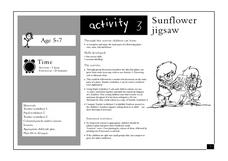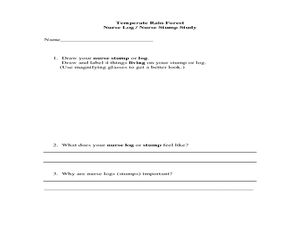Curated OER
From Flower to Fruit
Second graders examine the parts of a flower and how pollination occurs. In this flowers and pollination lesson, 2nd graders examine the parts of a flower with a hand lens focusing on the pollen. They watch as a pollinator such as a...
Curated OER
What Do Plants Need?
Learners experiment with plants. In this plant lesson, students research the needs of plants. Learners determine if all plants have the same requirements for growth. In small groups, students experiment with different plants.
Curated OER
Population Growth
Students grow duckweed, observe what happens when an organism population is allowed to grow without predation or competition, view videos about invasive species, and develop a proposal for controlling the growth of an invasive species in...
Curated OER
The Mural of the Story
Young scholars write a description of what they believe is on the ceiling of the Sistine Chapel. After reading an article, they discuss the restoration of the mural on its ceiling. They brainstorm a list of important buildings and...
Curated OER
Seed to Plant
Students understand the stages of a plants life. In this stages of plant development lesson, students read about bean plants and grow their own. Students record growth and photograph changes in their plants. Students label the parts of a...
Curated OER
Understanding Fair Trade
Fourth graders investigate the idea that anyone who works hard makes a lot of money. In this cocoa farming lesson plan, 4th graders understand the processes involved in cocoa farming and the profits gained by doing it.
Curated OER
Genetic Engineering
Keep your students up-to-date on the growing field of genetic engineering with these lesson plans.
Curated OER
With Liberty & Top Soil for All
Students compare the basic needs of plants to the basic needs of democracy. In this democracy comparison instructional activity, students complete a worksheet on what happens to a plant that's not nourished. Students draw a correlation...
Curated OER
Discovering Seeds
Young scholars compare seeds with seedlings. For this life science lesson, students make observations of seedlings and the seeds they grew from, paying special attention to the roots. Lesson includes extension activities.
Curated OER
PLANT LIFE CYCLES
Student learns about the life cycle of plants by watching a time-lapse video. This activity provides students with further evidence that all living things grow and change as they progress through their life cycle. Student conducts a...
Curated OER
Micro-Organisms
Students investigate micro-organisms with an on line activity. In this micro-organism on line lesson plan, students identify bacteria, viruses and fungi projected onto a white board. Students work in groups and use a computer and an on...
Curated OER
Jingles All the Way
Students explore various tactics used in advertising by studying the advertising campaigns of well-known companies. They earn about methods of political advertising in China by reading and discussing Political Power Grows From the Point...
Curated OER
Making the Personal Political
Students identify controversial topics on which they have strong opinions and model their own persuasive opinion pieces after the featured article. They compose persuasive essays on controversial issues that "hit home" for them.
Curated OER
Extraordinary Extrapolation
Students study how scientists have estimated the maximum height to which trees can grow, and assess the reliability of interpolation and extrapolation techniques by making predictions with particular data sets and analyzing accuracy of...
Curated OER
Sunflower Jigsaw
Students recognize and name the main parts of a flower. In this life science lesson, the teacher leads a discussion about the parts of a plant, then students color and cut out the parts of a planet, then glue the parts together...
Curated OER
A Frog's Life Story
Students examine a frog's life cycle. In this amphibians lesson, students read a book about frogs and discuss how frogs are born and how they grow. Students complete worksheets on the life cycle of the frog, and hold a discussion on the...
Curated OER
Animal Signs
Students discuss the many different types of animal signs that can be used to identify and track animals. They participate in an hands-on activity in which they examine tracks, trails, homes, territory markings, and even "scat" left by...
Curated OER
Our Changing Community
Students investigate how communities grow and change. In this communities lesson, students discuss how their community has changed and construct a model of a community.
Curated OER
Sleet and Hail Have Their Own Seasons
Second graders explain the definition of hail and sleet. In this precipitation instructional activity, 2nd graders discuss when hail and sleet fall and the results of hail falling.
Curated OER
Kick-Off Seed Explorations
Students explore fruit seeds and recognize that fruit seeds grow into plants like their parent fruit. For this seed lesson, students classify seeds. Students complete a KWL. Students name the fruit the seed is from.
Curated OER
Imagine a Kelp Forest
Students write a story based on their research of the kelp forest. In this ecosystem lesson, students view a video and research the kelp forest ecosystem. They write a short story imagining the discovery of a new species in the kelp forest.
Curated OER
Glacier Slide
Students conduct an experiment. In this glaciers lesson, students learn about glaciers and then perform an experiment to show how glaciers shape the landscape around them. Students draw a picture in their journals to illustrate their...
Curated OER
Temperate Forest : Pacific Spirit Field Trip
Students examine nurse logs with hand lenses and identify animals. In this ecosystem lesson, students gain understanding of the rainforest by studying nurse logs. Students become familiar with vocabulary through their study of nurse logs.
Curated OER
Canada and its Trading Partners
Students identify the relationship between Canada and its trading partners. They use two data sources, Canadian Statistics and E-STAT, on the Statistics Canada website to explore the growing importance of trade in general.

























